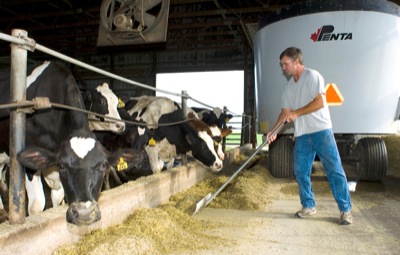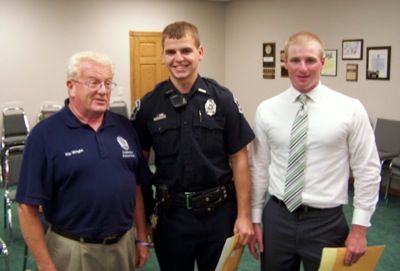Wednesday, July 25th, 2012
Farmers cutting herds due to feed losses
Drought fallout
By Nancy Allen

Photo by Mark Pummell/The Daily Standard
Lou Brown of Brownhaven Farm near New Bremen pushes feed toward his cattle this morning. Farmers anticipating food shortages due to the drought are selling their animals at a higher rate than normal.
Local dairy farmers are reducing their herds in anticipation of feed losses caused by the most widespread drought in seven decades.
"Our reports indicate that cull cattle numbers have increased 50 percent in the last 30 days, which tells us that farmers are anticipating a shortage of winter feed stocks," Chris Gibbs, executive director of the Mercer County Farm Service Agency, said. "Certainly our second cutting of hay was disappointing, but the third cutting is virtually nonexistent."
Anita Green, executive director of the Auglaize County FSA office, said cattle culling has increased 70 percent during the same time period.
Dairy farmers more than beef farmers rely on forages such as hay and corn silage to feed their animals. Many grow their own forage, which has been reduced greatly by the drought. This year the local corn and hay crops could be cut in half, Gibbs and Green have said.
Both FSA directors said they haven't seen such high dairy cattle reductions since the 1988 drought, though it did occur to a lesser degree in 2002, another dry year.
New Bremen area farmer Lou Brown said he sold five animals last week and will possibly sell five more this week. He doesn't know yet how much further he will reduce his 220-head herd, adding that will depend on his hay crop.
"It depends on what rains we get; we may get a decent fourth cutting of hay some time in August since we did get some rain," he said. "We'll definitely be buying feed, both corn and soybeans, and also hay from neighbors. We're looking everywhere in a two- to three-county area to find hay."
Celina area dairy farmer Garrett Hellwarth said he's sold some bottom-end cows, which in the long term will improve his herd, in order to stretch his feed supply. Like Brown, further culling will depend on his corn and hay yields.
"We may reduce the herd a little more; the price of beef is good right now so that helps the decision," Hellwarth said. "If she's of good meat value and marginal (milking) value, you can move her on."
Hellwarth said his corn has grown considerably due to recent rains, which will help provide more silage for his animals. He also has a field of very short corn that he may mow down and plant with oats to feed the cattle this fall.
Fort Recovery area dairy farmer Bob Guggenbiller said he isn't planning any major reductions to his 150-head milking herd, but added he will have to buy some outside feed.
"We were fortunate to have some carry-over hay, and we plan to buy some silage from neighbors," Guggenbiller said. "We've got three inches of rain in the last six to eight days, so we should get some more hay; it's going to help out a lot."
Other cattlemen throughout the middle and western part of the U.S. also are selling animals they can't graze or afford to feed. Beef from the animals now flooding livestock auctions will start showing up in grocery stores in November and December, temporarily driving down meat prices. But then prices are expected to rise sharply by January in the wake of dwindling supplies and smaller livestock herds.
The number of cattle in the U.S. has been dropping for years, but the pace picked up last year when ranchers in Texas, the nation's top beef producer, sold a massive number of animals amid a severe drought in the Southwest. Farmers in Nebraska, Montana, Wyoming and the Dakotas bought some of those cows, however, so nationwide, the loss wasn't as great as it could have been. This year, virtually no one is expanding herds.
"The drought was really bad in the Southern Plains last year, but the cattle industry was able nationally to absorb it because it wasn't bad everywhere. This one is much more along the lines of bad everywhere, so the market implications are a lot larger and a lot more players in the industry are impacted by this," Glynn Tonsor, an agriculture economics professor at Kansas State University, said.
The U.S. Department of Agriculture reported recently that the nation's cattle inventory was the smallest since the agency began a July count in 1973. The U.S. had 97.8 million head as of July, 2 percent less than a year ago.
In Oklahoma City, the number of cattle going to auction quad-rupled in one week earlier this month, and in Kearney, Neb., it increased three-fold. In Texas, some 36,000 cattle were brought to auctions last week - nearly triple the 13,400 animals sold just a couple of weeks earlier.
It is likely to take the beef industry years to recover. Cows have a nine-month gestation period, and it can take up to two years after calves are born for them to grow big enough for slaughter. The time needed to repair drought-damaged pastures will only extend that timetable because ranchers must have grass for grazing before they can add animals.
- The Associated Press contributed to this story.
Drought meeting:
Area farmers are invited to a free meeting 1-4 p.m. Aug. 2 at St. Charles Center on U.S. 127 to discuss agricultural issues related to the drought.
Jim Hoorman, Mercer County OSU Extension educator, said topics will include controlling mares tail in corn and soybeans, planting emergency forages to feed cattle, properly pricing drought-stressed corn for feed, how to manage excess nitrate levels in corn that is cut for silage, how to cut and store corn silage and how to feed it to cattle. There will be various speakers.
For information, contact Hoorman at 419-586-2179 or 419-421-7255.

